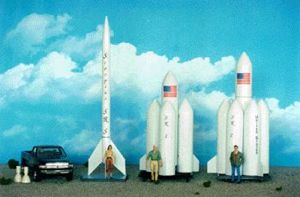
Home - Search - Browse - Alphabetic Index: 0- 1- 2- 3- 4- 5- 6- 7- 8- 9
A- B- C- D- E- F- G- H- I- J- K- L- M- N- O- P- Q- R- S- T- U- V- W- X- Y- Z
Scorpius
 Scorpius Credit: Microcosm |
AKA: Eagle SLV. Status: Development. Payload: 670 kg (1,470 lb). Apogee: 185 km (114 mi).
Microcosm, Inc. of El Segundo, California, began developing the Scorpius family of launch vehicles in the early 1990's. The company's Liberty 22 kN Lox/RP-1 engine was first fired in 2005. They also developed new methods of low-cost composite propellant tank fabrication to support use of simple, pressure-fed engines. Two suborbital test models, SR-S and SR-XM-1, flew successfully from White Sands Missile Range, New Mexico, in 1999 and 2001, respectively. Eventually Microcosm planned to market up to eight Scorpius variants: two suborbital vehicles, the SR-S and SR-M launchers; three light-lift orbital vehicles, the Sprite Mini-Lift, the Eagle SLV, and the Liberty Light-Lift launchers; one intermediate-lift orbital vehicle, the Antares Intermediate-Lift launcher; one medium-lift vehicle, the Exodus Medium-Lift launcher; and one heavy-lift vehicle, the Space Freighter.
Despite the wide range in their sizes and lift capacities, each Scorpius variant was based on a scalable modular design featuring simple LOX/Jet-A pressure-fed motors without turbopumps and low-cost avionics equipped with GPS/INS (global positioning system/inertial navigation system). The orbital variants were three stages and featured thick fuel tanks for added durability during flight.
The Scorpius system was designed simply in order to maximize the cost savings and quick launch pad turnaround times sought by government-sponsored responsive space initiatives. As a first step, the test launches of the suborbital SR-S and SR-XM-1 vehicles demonstrated Scorpius' ability to be ready for flight within 8 hours of arrival at the launch pad, using a crew of under 15. When marketed, the SR-S vehicle was advertised as able to suborbitally loft 100 kg to 200 km for $99,000. The SR-M would suborbitally 400 kg to 200 km for $295,000.
The Sprite Mini-Lift vehicle was projected to loft up to 318 kilograms to LEO. Eagle SLV would loft up to 670 kilograms to LEO. The Liberty Light Lift vehicle would loft up to 1,270 kilograms to LEO for $ 2 million.
Microcosm's intermediate-, medium-, and heavy-lift Scorpius included: the Antares Intermediate-Lift vehicle - 2,676 kilograms to LEO and up to 885 kilograms to GTO; the Exodus Medium-Lift vehicle - 6,713 kilograms to LEO and up to 2327 kilograms to GTO.
Microcosm received one of four contracts, valued at $10.5 million, from DARPA in September 2004 for phase 2 of the FALCON small launch vehicle program to support development of the Eagle SLV. However, the company was notified in August 2005 that it had not been selected for further work on the program. The company was continuing development of the Scorpius vehicle concept under a separate Defense Department contract.
LEO Payload: 670 kg (1,470 lb) to a 185 km orbit at 28.00 degrees.
Family: LCLVs, low cost, orbital launch vehicle. Country: USA. Engines: Liberty engine. Spacecraft: Wild Fire. Agency: Microcosm.
2001 March 9 - . Launch Vehicle: Scorpius.
- Scorpius SR-XM-1 suborbital rocket test - . Nation: USA. Program: X-Prize. Spacecraft Bus: X-Prize. Spacecraft: Wild Fire. Suborbital test of the Scorpius low-cost rocket concept. Later X-Prize contendor the da Vinci Project (Toronto, Canada) claimed this as a test of their "double engine propulsion system configuration"..
Back to top of page
Home - Search - Browse - Alphabetic Index: 0- 1- 2- 3- 4- 5- 6- 7- 8- 9
A- B- C- D- E- F- G- H- I- J- K- L- M- N- O- P- Q- R- S- T- U- V- W- X- Y- Z
© 1997-2019 Mark Wade - Contact
© / Conditions for Use